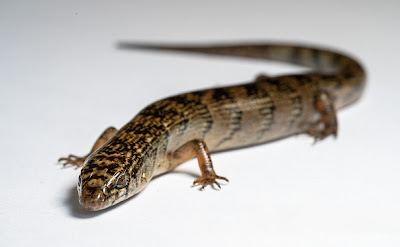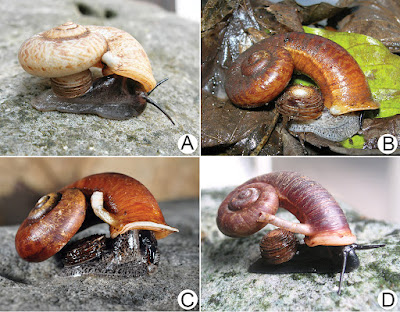 |
| Cyrtodactylus thongphaphumensis Grismer, Rujirawan, Chomdej, Suwannapoom, Yodthong, Aksornneam & Aowphol, 2023 |
Abstract
An integrative systematic analysis recovered a new species of the Cyrtodactylus brevipalmatus group from the uplands of Thong Pha Phum National Park, Kanchanaburi Province in western Thailand. Cyrtodactylus thongphaphumensis sp. nov. is deeply embedded within the brevipalmatus group, bearing an uncorrected pairwise sequence divergence of 7.6–22.3% from all other species based on a 1,386 base pair segment of the mitochondrial NADH dehydrogenase subunit 2 gene (ND2) and adjacent tRNAs. It is diagnosable from all other species in the brevipalmatus group by statistically significant mean differences in meristic and normalized morphometric characters as well as differences in categorical morphology. A multiple factor analysis recovered its unique and non-overlapping placement in morphospace as statistically significantly different from that of all other species in the brevipalmatus group. The description of this new species contributes to a growing body of literature underscoring the high degree of herpetological diversity and endemism across the sky-island archipelagos of upland montane tropical forest habitats in Thailand, which like all other upland tropical landscapes, are becoming some of the most imperiled ecosystems on the planet.
Keywords: Bent-toed gecko, genetics, Indochina, integrative taxonomy, montane forests, morphology
Cyrtodactylus thongphaphumensis sp. nov.
Suggested Common Name: Thong Pha Phum Bent-toed Gecko,
ตุ๊กกายทองผาภูมิ
Diagnosis: Cyrtodactylus thongphaphumensis sp. nov. can be separated from all other species of the brevipalmatus group by the combination of having 12–14 supralabials, 8–10 infralabials, 30–36 paravertebral tubercles, 19–21 rows of longitudinally arranged tubercles, 30–34 longitudinal rows of ventrals, 150–173 transverse rows of ventrals, 8–10 expanded subdigital lamellae on the fourth toe, 11–14 unexpanded subdigital lamellae on the fourth toe, 20–24 total subdigital lamellae on the fourth toe; seven or eight expanded subdigital lamellae on the fourth finger, 10–12 unexpanded subdigital lamellae on the fourth finger, 18–20 total subdigital lamellae on the fourth finger; 12–16 total number of enlarged femoral scales, 12–16 total number of femoral pores in males; 15 precloacal pores in males; 15–17 enlarged precloacals; enlarged femorals and enlarged precloacals not continuous; proximal femorals smaller than distal femorals; small tubercles on forelimbs and flanks; large dorsolateral caudal tubercles and wide ventrolateral caudal fringe; ventrolateral caudal fringe composed scales of different size; tail square in cross-section; maximum SVL 76.6 mm; 3–5 dark transverse body bands (Table 5).
...
Distribution: Cyrtodactylus thongphaphumensis sp. nov. is currently known only from the type locality at Thong Pha Phum National Park, Pilok Subdistrict, Thong Pha Phum District, Kanchanaburi Province, Thailand (Fig. 1).
Etymology: The specific epithet thongphaphumensis is in reference to the type locality of Thong Pha Phum National Park.
L. Lee Grismer, Attapol Rujirawan, Siriwadee Chomdej, Chatmongkon Suwannapoom, Siriporn Yodthong, Akrachai Aksornneam and Anchalee Aowphol. 2023. A New Species of the Cyrtodactylus brevipalmatus Group (Squamata, Gekkonidae) from the uplands of western Thailand. ZooKeys. 1141: 93-118. DOI: 10.3897/zookeys.1141.97624


















--2023_Makino_Nakano__.jpg)
--2023_Makino_Nakano__.jpg)
--2023_Makino_Nakano__.jpg)



















